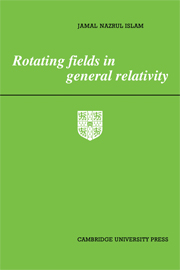5 - Rotating Einstein–Maxwell fields
Published online by Cambridge University Press: 10 May 2010
Summary
Introduction
In this chapter we shall be concerned with the exterior gravitational and electromagnetic fields of rotating charged sources. The electromagnetic field has energy stored in it and hence contributes to the energy-momentum tensor in the region exterior to the sources. We will not be concerned in this chapter with equations satisfied by the sources but consider only some general properties of the sources as reflected in the exterior field. All the solutions we mention in this chapter are exterior solutions of the Einstein–Maxwell (EM) equations. These solutions are also known as ‘electrovac’ solutions. A great deal of work has been done on the EM equations. In this chapter we shall mainly be concerned with some general classes of solutions and the physical property of the rotating sources that these exterior solutions reflect.
Papapetrou (1947) and Majumdar (1947) independently discovered electrostatic (non-rotating) solutions of the EM equations which are given in terms of a single harmonic function. These solutions have no spatial symmetry (i.e. they are non-axisymmetric), and are produced by sources with m=|e|, m and e being the mass and charge respectively in suitable units. We call these the PM solutions (these solutions are distinct from the Papapetrou solutions discussed in Section 2.5). Weyl's (1917) electrostatic (non-rotating) solutions of the EM equations (these are distinct from the Weyl solutions of Section 2.3 – in this chapter we shall always refer to the electrostatic solutions) have axial symmetry, but the sources satisfy m=βe where β is a constant, the same for all masses.
- Type
- Chapter
- Information
- Rotating Fields in General Relativity , pp. 67 - 86Publisher: Cambridge University PressPrint publication year: 1985



